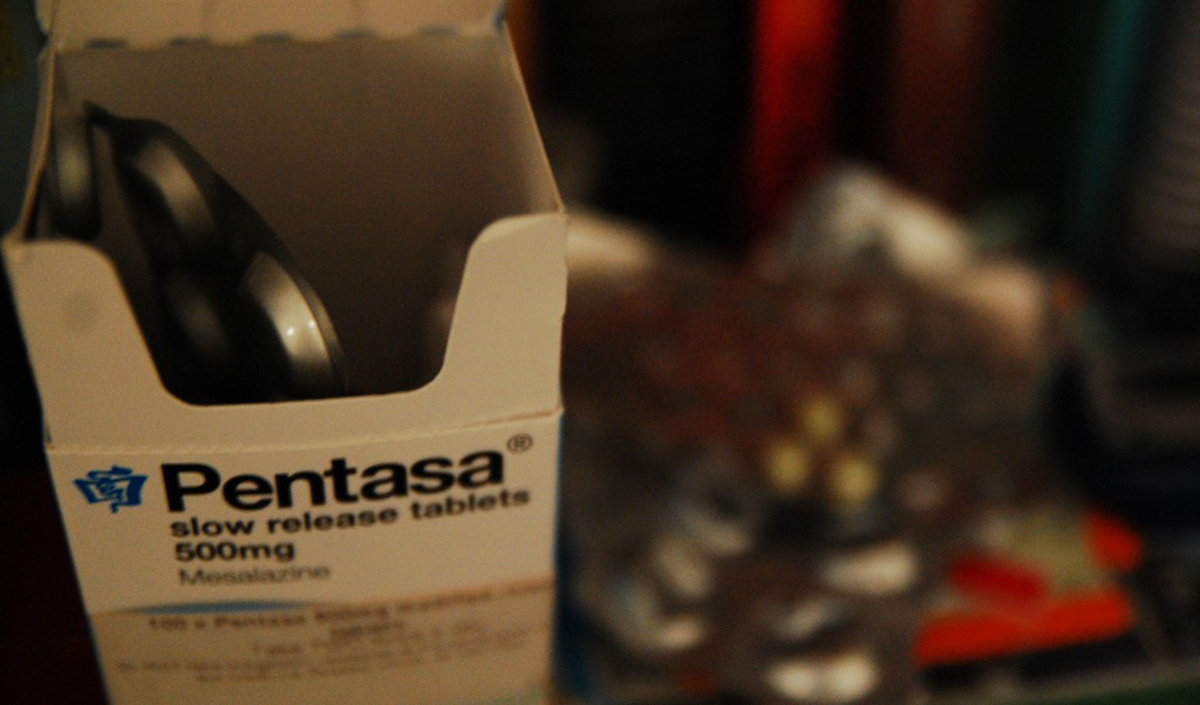Crohn’s disease is a type of inflammatory bowel disease that can affect any parts of the gastrointestinal tract. Variable manifestations of this condition and the fact that it is not very common complicate the diagnostics of this disease. Even when properly diagnosed and managed, the disease is associated with higher risk of bowel cancer and slightly reduced life expectancy.

Crohn’s disease is considered as a particular type of immune system disorder. In these disorders, body’s immune system attacks its own normal tissues resulting in various condition-specific problems.
This process is probably directed by the presence of certain bacteria. It was reported that certain types of E. coli are more common in people diagnosed with Crohn’s disease. The condition is often viewed as a type of immunodeficiency since the immune system of affected individuals is usually weakened.
The disease causes small ulcerations on the surface of intestine, which become larger and deeper as disease progresses. Deep ulcers can make holes in the wall of intestine leading to formations of fistulas. Formation of fistulas can cause abdominal abscess, fever and pain.
Crohn’s disease is relatively rare and affects approximately 3.2 persons per 1000 in the US and Europe. The disease is more common in industrialized countries. It appears that this rate is growing in recent decades, particularly in the developing countries.
Possible causes of Crohn’s disease
There is a strong underlying genetic component in the development of Crohn’s disease.
It is believed that roughly about half of the risk of developing Crohn’s disease comes from these genetic factors. For instance, gene NOD2 determines how body responds to certain products of bacterial metabolism. People with mutations in these gene may respond to the presence of some bacteria in such a way that their immune system become chronically over-activated and attacks not only bacteria but also normal tissue of gastrointestinal tract where those bacteria can be found.
In addition to the genetic predisposition, environmental, bacterial and immune factors may contribute to the disease development and progression. Smokers are twice more likely to be affected by this condition. Generally weak immune system of an individual may allow excessive growth of various microorganisms in mucosal layer of the gastrointestinal tract. One interesting theory suggests that the excessive hygiene typical for modern society does not allow the immune system to develop to the full strength due to the lack of extental stimuli in the form of various potentially dangerous microorganisms and parasites. The theory partially explains higher prevalence of Crohn’s disease in the developed countries with high standards of hygiene.
See Also: Crohn's disease- chronic inflammation of the digestive tract
It appears that increased consumption of meat increases the chances of developing this condition, while vegetable-based diets reduce these chances. Stress is also thought to play role in the disease development, although the evidences to support this point of view are limited.
Symptoms And Treatment Of Crohn’s Disease
Symptoms of Crohn’s disease and its Diagnosis
The symptoms of Crohn’s disease can differ between patients and may include the following:

- Abdominal pain, often accompanied by diarrhea, with or without blood
- Persistent vomiting and nausea
- Itchiness and pain around the anus, fistulisation or abscesses in the anal area
- Non-healing sores in the mouth.
The disease is characterised by periods of improvement followed by periods when symptoms flare up.
Crohn’s disease may cause a number of systemic symptoms, such as retardation of growth in the children, and the weight loss and diminished appetite in the adult patients.
It can cause inflammation of the interior portion of the eye (uveitis), development of gallstones, rheumatologic diseases (seronegative spondyloarthropathy which manifests itself as inflammation of joints or muscle insertions) and various skin lesions. Crohn’s disease is also associated with increased risk of blood clots and deep vein thrombosis, respiratory problems and anemia, osteoporosis and bone fractures. The risk of neurological complications is also increased in patients with this condition.
Diagnosis of Crohn’s disease can be rather difficult task. The procedures involved usually include biopsy of the bowel wall and various imaging techniques.
Treatment of Crohn’s disease
Unfortunately, like many other rare diseases, Crohn’s disease cannot be cured at present time.
Corticosteroids can be used to improve the condition of newly diagnosed patients. Associated infections and inflammations are treated with antibiotics and anti-inflammatory drugs.
Immunomodulators such as methotrexate and thiopurine are used for the prevention of recurrence. Immunomodulators are compounds that decrease inflammation in tissues by decreasing the activity of body’s immune system. Down-regulating the immune system may increase the chances of bacterial and other infections, but the benefits of symptomatic relief achieved by immunomodulators often overweight the risks associated with possibility of new infections.
Gradual loss of blood that often accompanies the disease may require the use of iron supplementation.
Surgical treatments are sometimes necessary to address more serious complications such as bowel obstructions and abscesses. Surgery does not cure Crohn’s disease. The removal of damaged part of gastrointestinal tract helps to resolve the immediate concerns, but after few months or years disease tend to return back at the new site in the digestive system, usually close to the site of removed damaged region. Around half of all Crohn’s disease patients who undergone surgery experience the return of disease and associated symptoms within 4 years after surgery.
See Also: How To Beat Crohn's Disease
Partially due to the lack of adequate treatments, many patients with Crohn’s disease turn to alternative medicines. Various herbal supplements, probiotics and diet modifications are sometimes recommended to these patients, but the evidences to support their efficiency are limited. The same applies to often used homeopathic approaches and acupuncture.
On the positive note, even though the disease does not have a cure, with adequate and timely symptomatic treatments most people with Crohn’s disease can live long and healthy life and even stay disease-free for many years and decades.
- Baumgart DC, Sandborn WJ (2012) Crohn's disease. The Lancet 380 (9853): 1590–605
- Molodecky, NA, Soon, IS, Rabi, DM, Ghali, WA, Ferris, M, Chernoff, G, Benchimol, EI, Panaccione, R, Ghosh, S, Barkema, HW, Kaplan, GG (Jan 2012) Increasing incidence and prevalence of the inflammatory bowel diseases with time, based on systematic review. Gastroenterology 142 (1): 46–54
- Burisch, J, Munkholm, P (Jul 2013) Inflammatory bowel disease epidemiology. Current opinion in gastroenterology 29 (4): 357–62
- Trikudanathan G, Venkatesh PG, Navaneethan U (2012) Diagnosis and therapeutic management of extra-intestinal manifestations of inflammatory bowel disease. Drugs 72 (18): 2333–49
- Shoda R, Matsueda K, Yamato S, Umeda N (1996) Epidemiologic analysis of Crohn disease in Japan: increased dietary intake of n-6 polyunsaturated fatty acids and animal protein relates to the increased incidence of Crohn disease in Japan. The American journal of clinical nutrition 63 (5): 741–5
- Joos S, Brinkhaus B, Maluche C, Maupai N, Kohnen R, Kraehmer N, Hahn EG, Schuppan D (2004) Acupuncture and moxibustion in the treatment of active Crohn's disease: a randomized controlled study. Digestion 69 (3): 131–9
- Photo courtesy of Holly Lay by Flickr : www.flickr.com/photos/hollylay/14406734266
- Photo courtesy of Jay Springett by Flickr : www.flickr.com/photos/thejaymo/8652317165

